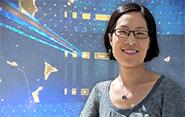Judy Cha: Mining Energy From New Materials

Hydrogen is the most abundant element in the universe, but turning it into a practical renewable fuel has long been a challenge for researchers. Producing it through the process of water-splitting has shown promise, but it requires finding a way to do so efficiently and inexpensively. One obstacle to this has been finding the right catalyst for the water-splitting process. Platinum has proved to work well, but it’s prohibitively costly, and researchers have been on the hunt for something cheaper.
Among the researchers working on this is Judy Cha, the Carol and Douglas Melamed Assistant Professor of Mechanical Engineering & Materials Science. One branch of her research involves a class of materials known as chalcogenides, which include sulfides, tellurides and selenides. They could be key to developing a practical form of water-splitting.
“Some of these materials have recently been found to be a reasonable catalyst to split water into hydrogen and oxygen,” she said, “so people are looking at the chalcogenides to see if they can improve their catalytic performance, and perhaps replace some of the more expensive catalysts.”
In Cha’s lab, at the Energy Sciences Institute (ESI) at Yale’s West Campus, she concentrates on the hydrogen side of water splitting. By applying voltage to these materials, Cha supplies electrons to the catalytic sites where electrons pair up with hydrogen-plus ions and create hydrogen gas – a process known as hydrogen evolution reaction. Cha has focused on the chalcogenide molybdenum disulfide (MoS2) and tungsten ditelluride (WTe2), playing with their morphologies and contact resistances to boost the hydrogen evolution reaction. These chalcogenides, in particular MoS2, have gotten a lot of attention in the field for their potential as an effective catalyst.
Researchers began looking at the use of chalcogenides for water-splitting in the mid-2000’s. Because much of the catalytic activities are happening on the surface of these materials, maximizing the surface space of chalcogenides is one of the goals. But Cha notes that this kind of research with these materials is a process fraught with variables. It’s not uncommon for a researcher to end up with a very promising finding, but unable to identify exactly which factors are responsible for the result.
“People make these nanostructure catalytic systems, but these systems are so complex,” she said. “You change one thing, and maybe you see the results you want, but what was it that was actually responsible for the improvement of your catalytic activity? It’s really difficult to know whether it worked because your design principle holds true, or because of some other side reactions you couldn’t anticipate.”
That’s why her lab emphasizes the process as much as the end result. That means developing nanoscale devices that she can control completely, allowing her to measure all aspects of the catalytic reactions, and see exactly what’s happening.
“Now that I can show this clearly, I can come up with design guidelines,” she said. “I think my own research is really about how I can better control the making of these materials and in the morphology and scale that I want.”
It’s not the track she originally set out on. While a Ph.D. candidate at Cornell, she mainly focused on analyzing the atomic arrangements of materials through electron microscopy. But when she went to Stanford University for her postdoctoral research, she became fascinated by the idea of making new materials.
“I realized I wasn’t really a characterization person, but that I’m more of an electronics properties materials person, and a want-to-solve-a-problem person,” she said.
It’s a role she’s taken on fully since coming to Yale in 2013, where she can delve into both the pure science of her field as well as seek out practical uses for it.
“The department I’m in – Mechanical Engineering & Materials Science – really fits who I am as a researcher,” she said “It’s about studying the fundamental aspects of materials, the science of materials, but also the engineering aspects of materials – improving them, and making them better for some actual application down the road.”
And it’s proved to be a good fit for ESI, where she was the first junior faculty hired. There, she shares an open lab space with three other junior faculty members. Although all four researchers are from different STEM disciplines, they share the same mission. Thanks in part to the open space, the four labs frequently work together. These collaborations are often initiated by the Ph.D. and post-doctoral students.
“It’s really exciting because even though we bring in different expertise, we have a common goal of trying to solve energy challenges,” she said.

